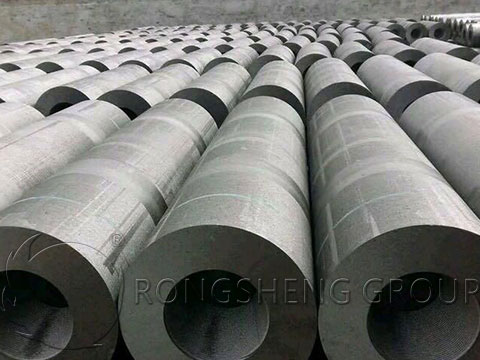Roasting is an important process for producing ultra-high-power graphite electrodes with excellent performance. By comparing the roasting furnace types and in-depth analysis of the heating mechanism of the green body during the roasting process. Understanding the effects of heating rate, binder pitch, temperature field and other factors on the quality of graphite electrodes can provide a reference for the production of high-quality graphite electrodes.

Ultra-high power graphite electrodes have the advantages of low resistivity, good oxidation resistance, and a small thermal expansion coefficient. It is widely used in arc steelmaking furnaces with high current density and harsh working conditions. Moreover, its bulk density and flexural strength also need to reach a high level. At the same time, its elastic modulus must be appropriate and matched with the performance of the matching electrode joint to demonstrate good thermal shock resistance during the electric furnace steelmaking process and not be easy to break. Therefore, it is necessary to strictly control the process parameters of each process of ultra-high power graphite electrode production to ensure that the product quality of each process is qualified and the internal structure of the product is uniform and stable. Therefore, continuously optimizing all aspects of process control is an effective means to obtain better quality products. The roasting process is the main factor affecting product quality.
Roasting Concept
Roasting means that the pressed green product (green body) is surrounded by air-isolating filler and continuously receives external heat to turn the binder asphalt in the product into asphalt coke. At the same time, it is combined with the carbon aggregate particles to form a strong integrated heat treatment process.
Comparison of Roasting Furnace Types
To adapt to the roasting of products of different sizes and varieties, different types of furnaces and control systems are designed. A wide variety of roasters have been developed based on improving productivity, reducing fuel consumption, controlling emissions, and improving quality. Up to now, the main furnace types of roasters include covered ring roasters, open ring roasters, car-bottom roasters, tunnel kilns, etc.
Currently, based on the traditional furnace type, the open ring roasting furnace has received new improvements. That is, a lightweight insulation cover is added to each furnace box, and the combustion nozzle structure is improved. This not only effectively solves the problem of unorganized exhaust gas emissions, but also achieves the low-nitrogen combustion effect of the combustion system.
Mechanism Analysis of the Whole Process of Roasting and Heating
For primary roasting, whether it is an externally fired ring roaster (open ring roaster), an internal combustion ring roaster (covered ring roaster), or a car-bottom roaster. They all conduct the heat generated after the fuel is burned to the refractory bricks or steel drums where the container is roasted. Then it is transferred to the filler by refractory bricks or steel drums. Finally, the filler transfers heat to the raw product. When the temperature felt by the green product itself exceeds the softening point of the binder asphalt, the green body first softens from the glassy state and then becomes a molten state. Just under the squeeze of the surrounding filler, it maintains its original geometric shape.
The selection and control of the roasting process is very important. Because it directly determines the structure, performance, and length of the product production cycle of the final product. During the roasting process, there are chemical reactions and transfers of mass, heat, and momentum. The three-phase system undergoes a series of continuous anisothermal phase transitions, making the study of the system very complicated.
